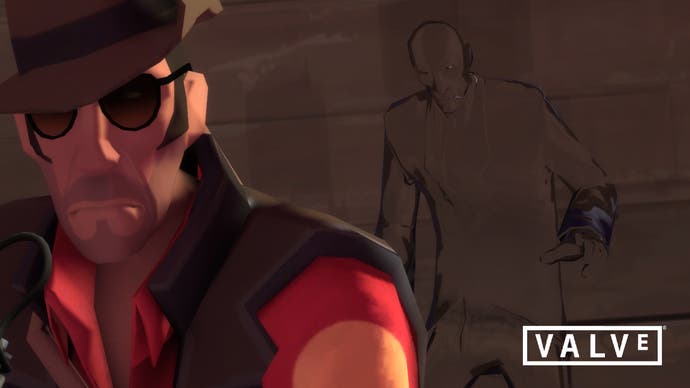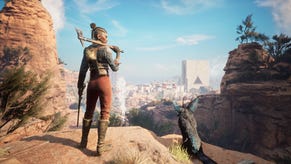Team Fortress 2
Smile some more.
In Team Fortress 2, Valve's fort-versus-fort multiplayer FPS, the devs have tried to apply the lessons they learned about iterative design to a multiplayer game. It is, in designer Robin Walker's words, "the first time we've got our shit together enough to do this" (and they've had a few goes - TF2 was originally announced in 1998). One of the words we hear a lot is "pacing". "We've always thought of pacing as a crafted thing in single-player," says Walker. "We spent a lot of time in Half-Life 2 crafting the highs and lows." Now TF2 has them - instead of standing around defending the base ("a flat experience"), you're forced to deal with rapidly evolving situations, like a Medic and Heavy Weapons Guy combining to capitalise on the former's temporary burst of invulnerability. When an enemy moves your flag, it will take 30 seconds to return to its home even if you touch it, forcing you to adjust your area of defensive focus. Similarly, get halfway through capturing a control point before death and your partial control will gradually diminish, giving the next wave the chance to resume the attack, and forcing the defending team to keep more of an eye on it. The dynamic changes minute to minute.
Another lesson was letting the gameplay inform the design. The stylised art - TF2's most striking facet - was a direction signposted by the game itself. "We always had a nagging feeling we weren't doing art direction right in all of our titles, even with Half-Life 2, where we were quite happy with the art direction," says Walker. The problem was conceptualising artwork before the team really knew what the product was - sort of like colouring in before anyone's drawn the lines. Done the other way around, Valve's able to design things specifically to solve game design problems. Character classes all have distinctive silhouettes so you can spot them at distance, while player models are coloured in a gradient that's at it's brightest at chest height - because human eyes focus on areas of high contrast, and that's where you need to look to see what your enemy's carrying.

The art's working hard everywhere you look - the Heavy Weapons Guy obviously has more health than the Scout because he's that much bigger. And of course you'll realise what the Medic's medi-gun does - red crosses flow along the stream it pumps into your team-mates. "100% of playtesters knew what it was the second they saw it," says Walker. Tellingly, there was only one point in our entire playtest that we had trouble identifying enemies, and by the time we noticed, Valve was already halfway through apologising for the level's unfinished lighting conditions. The benefits extend beyond characters. Team Fortress' most iconic map, 2Fort, is a pair of opposing bases separated by a watery pit with a covered walkway, but now they're farms, concealing underground spy-bases. As a result, you can easily gauge how much danger you're in. Within your own spy-base? Then you're comfortable. In the farm? Bit of danger. In their farm? Fair bit of danger. In their base? Oh, you're dead.
Then there are the classes themselves. "The whole point is that each class is a bottled-up experience, and that that experience is unique within the classes," says Walker, who's concerned that Team Fortress Classic - the Half-Life 1 "stopgap" mod released just after Valve acquired Team Fortress Software in the late '90s - didn't do a good enough job of this. TF2 aims to play into the variety of skill-sets that exist among players, not least because Valve knows that in multiplayer the content you're consuming is generated by other players, and it's more compelling if it's diverse in nature. So there's the Soldier, a fun entry class for rocket-jumping Quakers and a powerful attacker, while the Pyro's almost a melee class, with its flamethrower doing more damage in close quarters, and the Demo Man's a versatile choice for players who want to move between attack and defence, thanks to its grenade launcher's mixture of detonation options: on impact, after a few seconds, or upon remote input. The Sniper, bound to be popular, gets more punch out of its high-velocity rounds if you stay zoomed in for a few seconds at the cost of peripheral vision. Tempting, but dangerous.






.png?width=291&height=164&fit=crop&quality=80&format=jpg&auto=webp)


